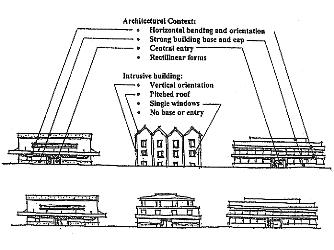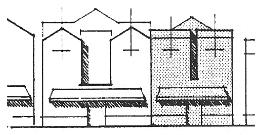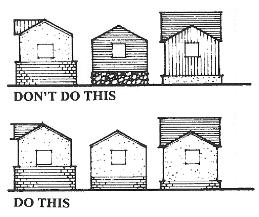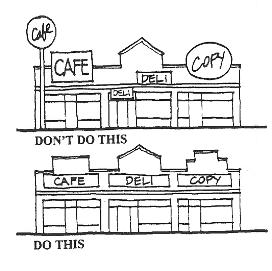20D.40.20 Context Design Standards.
20D.40.20-010 Purpose.
The purpose of this section is to identify existing neighborhood characteristics that should be enhanced or incorporated into the designs of new development projects. In addition, the standards address neighborhood compatibility and transitions between adjacent land uses, buildings, and street frontages. (Ord. 2164; Ord. 1993)
20D.40.20-020 Design Contexts.
(1) Intent.
(a) To provide contextual references that can be used to encourage distinctive designs for new development and redevelopment projects.
(b) To create contexts that capture the community visions and values as reflected in the Comprehensive Plan, neighborhood plan, and/or Design Review Handbook. Contextual elements could include the following:
(i) Context Defined by Natural Forms and Patterns. These are natural landforms found in the Sammamish River Valley and other parts of the City. Examples include river contour forms; river bench terraces; multiple silhouette ridgelines; and panoramic vistas with associated mountain, lake, river, and gully forms.
(ii) Historic and Cultural Context. Historic landmarks and the section of Leary Way framed by older historic structures have been identified as contributing to the historic character of the City. In addition, Redmond’s native peoples and Redmond’s heritage as a logging and farming community, and as a historic urban crossroads, define the more general historic and cultural context of the city.
(iii) Architectural Context. This includes buildings with articulated facades, pedestrian-friendly scale and detailing, historic building features or character, and interesting rooflines.
(2) Design Criteria.
(a) Site development should blend with natural landforms and be designed to maximize scenic views identified as public view corridors.
(b) Developments that have a historic or cultural context should incorporate or enhance historic or cultural references with the use of symbolic design details, interpretive signs or informational plaques.
(c) Developments within an area that has a distinctive architectural context should carry it forward with similar structure types and materials and, where appropriate, consistent architectural detailing.
In this example the middle building does not fit with the architectural context set by its neighbors.
Figure 1: Context Design Criteria (2)(c) of this section and Relationship to Adjacent Properties Criteria, RCDG 20D.40.20-030(2)(b).
In this example, the middle building better fits its architectural context because the horizontal banding, cap, base and central entry relate to neighboring buildings.
(Ord. 2340; Ord. 2164; Ord. 1993)
20D.40.20-030 Relationship to Adjacent Properties.
(1) Intent.
(a) To promote the functional and visual compatibility between adjacent neighborhoods and different land uses;
(b) To encourage building designs which use natural, historical, traditional, and/or cultural context references to create elements which link the development to the neighborhood and community;
(c) To use building design to create a transition between development and natural features;
(d) To promote a gradual transition between different uses.
(e) To encourage development that responds to the aesthetic, natural and recreational values of a shoreline location, through appropriate building design and orientation, and adequate visual and physical linkages to the shoreline.
(2) Design Criteria.
(a) Coordinate proposed development with surrounding site planning and development efforts on adjacent properties and throughout the neighborhood.
(b) Development should consider the following design features to create visual continuity between the proposed development and adjacent neighborhoods and the community.
Figure 2: Relationship to Adjacent Properties Criteria (2)(b)(i) and (2)(b)(ii) of this section.
Good design can reduce the apparent size of new buildings, allowing them to fit in with smaller buildings.
(i) Site design features to consider:
(A) Building setbacks;
(B) Placement of structures;
(C) Location of pedestrian/vehicular facilities; and
(D) Spacing from adjoining buildings.
(ii) Planting design features to consider:
(A) Composition of plant materials;
(B) Type and quantity of plant materials; street trees; and significant trees.
Figure 3: Relationship to Adjacent Properties Criteria (2)(b)(iii) of this section.
Example of a new building emphasizing the height, proportions, and canopy of the adjacent buildings.
(iii) Building design features to consider:
(A) Scale;
(B) Massing;
(C) Proportion;
(D) Spacing and location of windows, doorways and other features;
(E) Roof silhouette;
(F) Facade proportions and orientation;
(G) Location of entries;
(H) Surface material, finish, color and texture of surrounding development; and
(I) Style of architecture.
Figure 4: Relationship to Adjacent Properties Criteria (2)(b)(iii) of this section.
This example shows the use of compatible materials as the unifying element.
(iv) Sign design features to consider:
(A) Number, size and location of signs;
(B) Type of illumination;
(C) Color;
(D) Design restraint in relationship to the subject building and adjacent properties;
(E) Compatibility with building design.
Figure 5: Relationship to Adjacent Properties Criteria (2)(b)(iv) of this section, Signs.
Signage should be coordinated and be compatible with the building design and materials.
(c) In some areas, the existing context is not well defined, or may be undesirable. In such cases, the new development should be recognized as a pioneer with the opportunity to establish a pattern of identity from which future development can take its cues. The site’s zoning and other relevant Comprehensive Plan policies should be considered as indicators of the desired direction for the area and project.
(d) Properly link proposed development to existing and planned walkway, trail, street drainage and utility systems, and assure efficient continuation of such systems.
(e) Consider impacts to historic structures or sites, and mitigate potential impacts.
(f) Consider the impact of building mass, color, lighting, and design upon adjacent open spaces, continuity of identified public view corridors, public open spaces or parks, and recreation areas.
(g) Designs shall minimize impacts to historic structures or sites, and mitigate impacts through such means as:
(i) Developments adjacent to historic landmarks should ensure that significant features of historic landmarks are not obscured from public view. In cases where this is not fully possible, developments shall mitigate with photo documentation showing the significant features that will be obscured and/or the relationship of the structure to that adjacent site prior to construction of the obscuring structure.
(ii) Use of color on adjacent structures that allows existing historic landmarks to remain prominent within the immediate area.
(iii) Use of materials or design that emulate existing historic landmarks but which can be differentiated in age from that of the landmark.
(iv) Views from the new development may include views of significant features of the historic landmark. (Ord. 2486; Ord. 2340; Ord. 2164; Ord. 1993)
20D.40.20-040 Relationship to Street Front.
(1) Intent.
(a) To create a relationship between a development and the street front that provides safety and amenities for a development’s residents, employees, and customers, and for surrounding properties.
(b) To relate residential development to the street front that helps define neighborhood character. For example, residential areas with porches and balconies can create a sense of community and improve safety along public sidewalks and streets.
(c) To relate commercial development to the street front to ensure active street environments that encourage pedestrian activity, stimulate business, and encourage walking as a transportation mode. For example, commercial buildings with windows and entries oriented to the street can enhance pedestrian activity.
(d) To create an attractive street edge and unified streetscape, and provide pedestrian access where it does not conflict with private property security issues.
(2) Design Criteria.
(a) Building setbacks from public streets should be minimized in commercial developments.
(b) All development shall include site-planning measures to create an attractive street edge and accommodate pedestrian access. Examples of ways that a development meets the requirements of this provision are provided in subsections (2)(b)(i) through (iv) of this section.
(i) Define the street edge with buildings landscaping or other features.
(ii) Provide for a sidewalk at least five feet wide if there is not space in the public ROW.
(iii) Provide building entries that are accessed from the sidewalk. Preferably these access ways should be separated from the parking and drive aisles. If access traverses the parking lot, then it should be raised and clearly marked.
(iv) For businesses which require outdoor display oriented to the street, such as nurseries and auto sales, the street edge shall be defined.
(c) Create a well-defined streetscape to allow for the safe movement of pedestrians. Wherever possible, minimize building setbacks and relegate parking and drive-through passageways to the side and rear of all buildings.
(d) Provide site development features that are visible and pedestrian accessible from the street. These features could include plazas, open space areas, employee lunch and recreational areas, architectural focal points, and accent lighting. (Ord. 1993)


